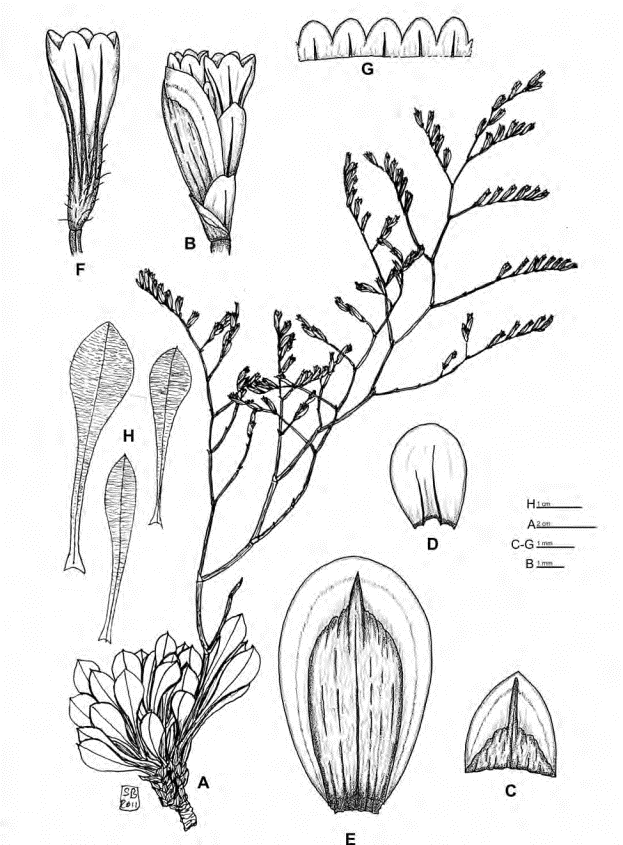LIMONIUM CRETICUM
1. Limonium creticum Artelari (1989b: 415) (Fig. 43)
Type:-GREECE. Crete: Kriti island, Nomos Irakliou, Ep. Pirgiotissis: on maritime marls of village Matala, 2 June 1988,
Artelari & Chondropoulos 1028 (holotype UPA, isotypes B!, C!, L!, M!, W!, Herb. Erben!).
= Limonium rigidum A. Mayer (1995: 93). Type:-GREECE. Crete: Crete, Ep. Pirjiotissis, 1 km N of Kalamaki, 5 km SW of Timbaki. Eroded cliff, on yellowish marls, 29 June 1990, Mayer 0689 (holotype M!, isotype Herb. A. Mayer).
Description:-Plant perennial, glabrous, forming a sub-shrub 20-50 cm tall, with few erect stems and a robust tap- root. Caudices 2-15 cm long, branched, spirally leafy in the upper half, living leaves in rosettes at apices. Leaves coriaceous, flat, rigid, grey-olivaceous, scabrous, 25-85 mm long and 8-20 mm broad, spathulate to oblanceolate, apex obtuse to rounded, cuspidate to mucronulate, with one central nerve, gradually tapering into the petiole. Stems normally robust, 15-45 cm long, more or less flexuous, verrucate to rugose, branching begins frequently near the base. Inflorescence obtrullate in outline. Sterile branches absent or only 1-3 per stem, straight to arched, 0.5-8 cm long, mostly unbranched. Fertile branches robust, 3-18 cm long, slightly arched to straight, forming branching angles of 40°-60°, branched. Spikes 15-80 mm long, straight to arched, inserted obliquely. Spikelets 6.6-7.3 mm long, composed of 1-3 flowers, remotely arranged with 2-4 per cm, sometimes laterally slightly curved near the base. Outer bract 2.5-3.0 mm long and 2.0-2.5 mm broad, more or less narrowly triangular-ovate, acute; bract margin broadly membranous; central part slightly fleshy, sometimes only at the base, acuminate. Middle bract membranous, 2.6-3.2 mm long and 1.9-2.5 mm broad, oblong-obovate, rounded. Inner bract 6.2-6.8 mm long and 4.1-4.8 mm broad, obovate, rounded; bract margin very broadly membranous; central part fleshy, somewhat hard, 4.9-5.3 mm long and 2.4-3.0 mm broad, oblong to elliptic, acuminate, forming a triangular tip, 0.8-1.0 mm long, not reaching the upper margin. Calyx 5.1-6.4 mm long, exceeding the inner bract by 0.5-1.5 mm; calyx tube more or less sparsely long hairy, with 5 ribs ending above the base of lobes; calyx lobes ca. 0.7 × 0.9 mm, broadly semi- elliptic. Corolla violet.
Chromosome number:-2n = 51 (Artelari 1989b).
Distribution:-Restricted to Crete, where it grows in the northwest coast between Chania and Cap Drapano, and in the central-southern part between Timbaki and Kali Limenes (Fig. 88E).
Habitat:-Calcareous and marly rocky coast.
Taxonomic remarks:-L. creticum is closely related to L. minoicum, from which it differs by having 1-nerved leaves, and longer spikelets, bracts and calyces. From L. sieberi it differs by having 1-nerved, grey-olivaceous leaves and from L. hierapetrae by having more densely arranged leaves, shorter outer bracts and longer inner bracts.
Type:-GREECE. Crete: Kriti island, Nomos Irakliou, Ep. Pirgiotissis: on maritime marls of village Matala, 2 June 1988,
Artelari & Chondropoulos 1028 (holotype UPA, isotypes B!, C!, L!, M!, W!, Herb. Erben!).
= Limonium rigidum A. Mayer (1995: 93). Type:-GREECE. Crete: Crete, Ep. Pirjiotissis, 1 km N of Kalamaki, 5 km SW of Timbaki. Eroded cliff, on yellowish marls, 29 June 1990, Mayer 0689 (holotype M!, isotype Herb. A. Mayer).
Description:-Plant perennial, glabrous, forming a sub-shrub 20-50 cm tall, with few erect stems and a robust tap- root. Caudices 2-15 cm long, branched, spirally leafy in the upper half, living leaves in rosettes at apices. Leaves coriaceous, flat, rigid, grey-olivaceous, scabrous, 25-85 mm long and 8-20 mm broad, spathulate to oblanceolate, apex obtuse to rounded, cuspidate to mucronulate, with one central nerve, gradually tapering into the petiole. Stems normally robust, 15-45 cm long, more or less flexuous, verrucate to rugose, branching begins frequently near the base. Inflorescence obtrullate in outline. Sterile branches absent or only 1-3 per stem, straight to arched, 0.5-8 cm long, mostly unbranched. Fertile branches robust, 3-18 cm long, slightly arched to straight, forming branching angles of 40°-60°, branched. Spikes 15-80 mm long, straight to arched, inserted obliquely. Spikelets 6.6-7.3 mm long, composed of 1-3 flowers, remotely arranged with 2-4 per cm, sometimes laterally slightly curved near the base. Outer bract 2.5-3.0 mm long and 2.0-2.5 mm broad, more or less narrowly triangular-ovate, acute; bract margin broadly membranous; central part slightly fleshy, sometimes only at the base, acuminate. Middle bract membranous, 2.6-3.2 mm long and 1.9-2.5 mm broad, oblong-obovate, rounded. Inner bract 6.2-6.8 mm long and 4.1-4.8 mm broad, obovate, rounded; bract margin very broadly membranous; central part fleshy, somewhat hard, 4.9-5.3 mm long and 2.4-3.0 mm broad, oblong to elliptic, acuminate, forming a triangular tip, 0.8-1.0 mm long, not reaching the upper margin. Calyx 5.1-6.4 mm long, exceeding the inner bract by 0.5-1.5 mm; calyx tube more or less sparsely long hairy, with 5 ribs ending above the base of lobes; calyx lobes ca. 0.7 × 0.9 mm, broadly semi- elliptic. Corolla violet.
Chromosome number:-2n = 51 (Artelari 1989b).
Distribution:-Restricted to Crete, where it grows in the northwest coast between Chania and Cap Drapano, and in the central-southern part between Timbaki and Kali Limenes (Fig. 88E).
Habitat:-Calcareous and marly rocky coast.
Taxonomic remarks:-L. creticum is closely related to L. minoicum, from which it differs by having 1-nerved leaves, and longer spikelets, bracts and calyces. From L. sieberi it differs by having 1-nerved, grey-olivaceous leaves and from L. hierapetrae by having more densely arranged leaves, shorter outer bracts and longer inner bracts.

FIGURE 43. Limonium creticum Artelari. A) Habit; B) Spikelet; C) Outer bract; D) Middle bract; E) Inner bract; F) Calyx; G) Calyx lobes; H) Leaves. (Habit and leaves drawn from “Creta, Matala, Brullo & Giusso s.n., CAT”, spikelet details from “R. Artelari & Chondropoulos 1028, M”).